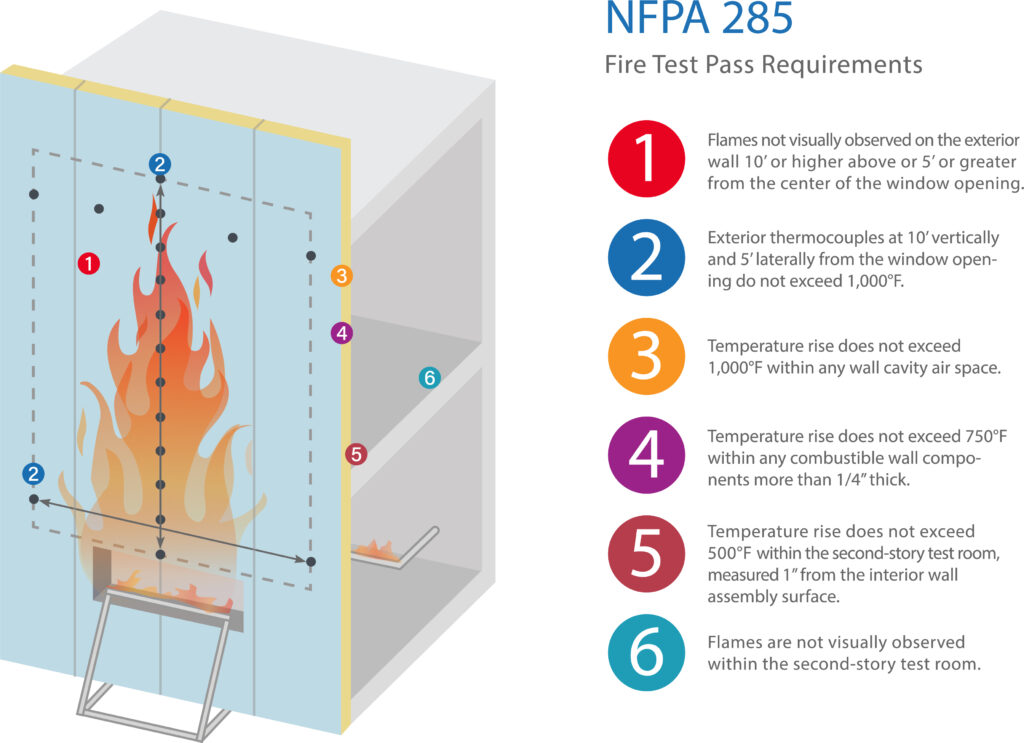This is the second in a multi-part series of articles on the topic of testing and design for exterior wall assemblies that the building codes require to comply with NFPA 285. These articles are intended to promote effective communication between stakeholders regarding this important fire safety topic for the design and construction of code-compliant exterior wall assemblies.
As much as providing a Pass / Fail determination, one of the most valuable benefits of the NFPA 285 test is the type and amount of data that is collected. This aspect of NFPA 285 makes it an extremely effective tool to conduct tests and analyze test data for assemblies configured to present “worst case” conditions for components, geometries, or combinations of both. When tested and found to meet the acceptance criteria, the data for these “worst case” configurations forms the basis for analysis and reasonable extension to other assemblies of similar composition and configuration to, but not exactly the same as, the tested assembly. From a more practical perspective, this ability to extend data is advantageous to all stakeholders because given the number of potential combinations and permutations of products in the control layers of modern exterior wall assemblies, it would be impossible to test each and every configuration and combination of components.
Experience with NFPA 285 has shown that certain test specimen design and configuration details may influence test results more
than others. Technical revisions to the 2019 Edition of NFPA 285 were made to ensure the test provides a more consistent and challenging test (e.g., prescribed locations for exterior veneer joints / seams and prescribed procedures for window closures [with an option for closures per the manufacturer’s instructions]) and to ensure that important configuration details are both recorded and clearly communicated in test reports (e.g., required drawings / details for the wall cross-section and window closure if the per-manufacturer option is used).
Experience with NFPA 285 has also shown that every NFPA 285 test is an opportunity to gain further insight into how products and wall assembly configurations perform in this important fire performance aspect of exterior walls of buildings. The 2023 Edition of NFPA 285 contains a new Annex B representing the collected experience and consensus of a Task Group of stakeholders, convened under the NFPA Committee on Fire Tests, that included experts in fire testing, fire science, and fire protection engineering representing testing and certification organizations, fire consultants, product manufacturers, and industry associations. The Annex provides important information and guidance for the analysis of specific subjects and changes to a tested assembly as well as very important limitations and when certain changes should not be permitted.
When it comes to the actual testing of wall assemblies, building product manufacturers will design test specimens and test programs, often with the advice of qualified consultants, that build in scenarios for extending successful test results. One result of this “worst case” approach to fire testing is that tested assemblies are not likely to reflect actual designs prepared by the designer, for example:
A “weak” window closure, from a fire performance perspective, will be tested to allow for analysis and extension of test results to more robust closures used in actual designs.
A greater amount of combustible componentry (e.g., insulation thickness, water-resistive barrier thickness, etc.) will be tested to allow analysis and extension of test results to actual designs using lesser amounts of those combustible components.
A less robust base wall, from a fire performance perspective (i.e., light-gage metal framing), will be tested to allow for extension of test results to more robust base walls (i.e., masonry, precast concrete, etc.) to be used in actual designs.

The value of NFPA 285 goes beyond its binary pass / fail test result and reference within the requirements of the International Building Code® (IBC). Visual and instrument data collected during these tests provides experts with information allowing experts insight about how each assembly layer behaved throughout the test, leading up to the final test result for the complete assembly. This dynamic performance information is objective evidence for expert analysis and extension to other similar wall assemblies based on experience, fire science principles, and guidance information within the NFPA 285 test standard, itself.

